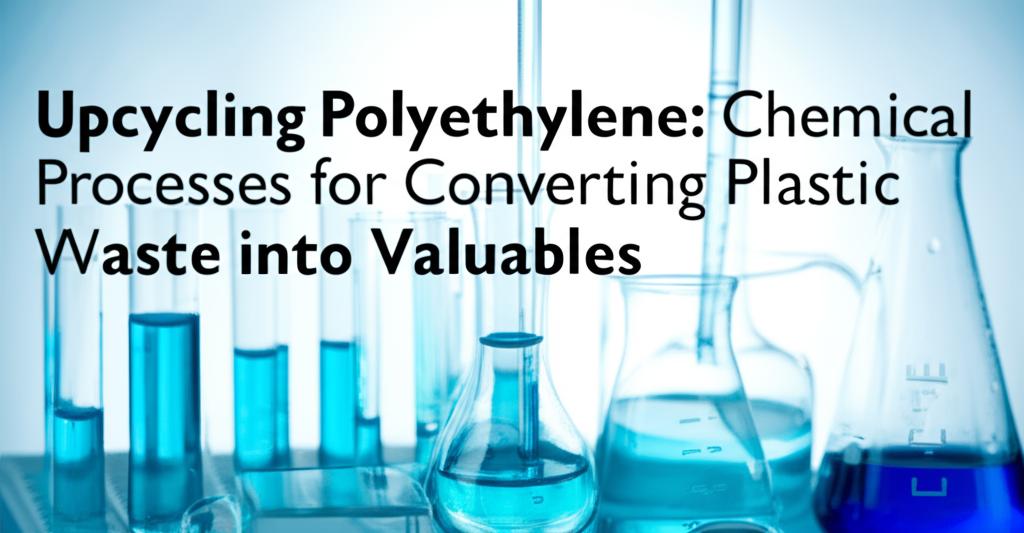Polyethylene (PE), one of the most widely produced plastics, presents a significant environmental challenge due to its persistence and the large volume of waste generated. Traditional mechanical recycling often results in lower-value products, prompting researchers to explore chemical upcycling methods. These processes aim to break down PE into its constituent molecules or transform it into new, higher-value materials, contributing to a more circular economy.
Recent advancements in chemical upcycling of PE span various techniques, each with unique approaches and outcomes:
1. Thermal and Catalytic Cracking (Pyrolysis and Gasification):- Pyrolysis: This process involves heating PE in an oxygen-free environment to break it down into a mixture of hydrocarbons. These can include gases, oils (similar to diesel fuel), and waxes. The resulting pyrolysis oil can be used as a fuel or further processed into new chemicals and plastics. While effective in converting PE waste into valuable fuels and chemicals, challenges include potential secondary pollution if harmful gases and particulate matter are not properly managed, complex operation, and high investment costs.
- Catalytic Cracking/Pyrolysis: The addition of catalysts can lower the reaction temperature and improve the selectivity of the products. Zeolite-based catalysts have shown potential in producing fuel oils. Researchers at the University of Guelph have developed a Graphene-based Metal-Organic Framework (GMOF) catalyst for PE pyrolysis, selectively producing smaller hydrocarbons like propylene, which is a precursor for polypropylene (PP).
- Hydrocracking/Hydrogenolysis: This method uses hydrogen and a catalyst to break down PE into shorter-chain alkanes, which can be used as lubricants, waxes, or fuels. Ruthenium-based catalysts (e.g., Ru/C, Ru on tungstated zirconia, Ru/SrTiO₃) have shown high activity, though ruthenium's cost and methane production are drawbacks. Nickel-based catalysts (e.g., Ni/SiO₂) are also being explored as a more cost-effective alternative, achieving significant conversion into hydrocarbons. Cobalt supported on ZSM-5 zeolite has demonstrated high selectivity in converting PE into propane.
- Gasification: This thermochemical process converts plastic waste into syngas (a mixture of hydrogen and carbon monoxide) by reacting it with a controlled amount of oxygen or steam at high temperatures. Syngas is a versatile feedstock for producing various chemicals and fuels.
- PE and CO₂ to Aromatics: An innovative approach involves the tandem catalysis of PE and carbon dioxide (CO₂) to produce aromatics (like benzene, toluene, and xylene) and carbon monoxide (CO). This method utilizes catalysts like Cu-Fe₃O₄ and Zn/ZSM-5 and can surpass theoretical limits for aromatic selectivity in PE aromatization by consuming excess hydrogen to convert CO₂ into valuable CO.
- Catalytic Depolymerization with Co-Reactants: Introducing co-reactants like light n-alkanes or ethylene during catalytic processes can help convert PE into specific products like liquid fuels or lubricants at lower temperatures.
- Ethylene and Base-Metal Heterogeneous Catalysts: Researchers at UC Berkeley have developed a process using a combination of tungsten oxide on silica and sodium on gamma-alumina as catalysts. This method efficiently converts PE (and PP, or mixtures) into propylene and isobutylene with high yields (over 90%) at around 320°C without prior dehydrogenation. This approach uses cheaper, reusable solid catalysts suitable for continuous flow processes.
- Light-Driven Photocatalysis: Scientists have developed methods using sunlight and non-toxic photocatalysts (e.g., titanium dioxide with atomically dispersed metal catalysts like palladium) to convert PE waste into valuable chemicals like ethylene and propionic acid at room temperature. This "waste-to-value" strategy offers a greener alternative to energy-intensive industrial processes.
- Photoelectrocatalysis: Combining light and electrical energy can also promote plastic degradation and transformation.
- A novel approach uses Lewis acidic AlCl₃/NaCl molten salts as both catalyst and reaction media to upcycle PE into liquid alkanes. This method operates at relatively low temperatures (below 200°C) without the need for external solvents, hydrogen sources, or noble/transition metal catalysts, proceeding via a repeated cracking-alkylation pathway.
- Hydrothermal Treatment (HTT): This newer technology uses supercritical water to heat and dissolve mixed plastic waste. It avoids direct combustion, potentially producing higher product yields and fewer toxic byproducts than pyrolysis, though it requires further optimization for commercialization.
- Hybrid Chemical/Biological Upcycling: This strategy involves initial chemical pretreatment of plastics to make them more accessible to microbial degradation or conversion into value-added products. While more developed for plastics like PET, research is ongoing for polyolefins like PE.
- Macromolecular Transformation: This involves modifying the polymer structure to create new materials with different properties, rather than completely breaking it down into small molecules.
The overarching goals of these chemical upcycling processes for polyethylene are to:
- Reduce plastic waste in landfills and the environment.
- Create valuable products, thereby establishing a more circular and economically viable plastic economy.
- Decrease reliance on fossil fuels for producing virgin plastics and chemicals.
- Lower the energy consumption and environmental impact associated with plastic recycling.
Despite promising advancements, challenges remain. These include achieving high selectivity for desired products, managing contaminants in mixed plastic waste streams, developing cost-effective and robust catalysts, scaling up processes for industrial application, and ensuring the overall energy efficiency and environmental sustainability of these methods. Continued research and innovation are crucial to overcoming these hurdles and realizing the full potential of chemically upcycling polyethylene waste.

